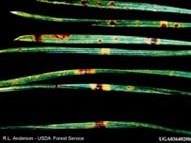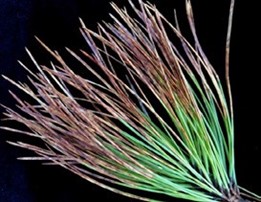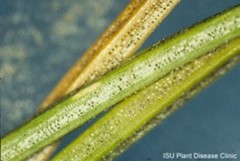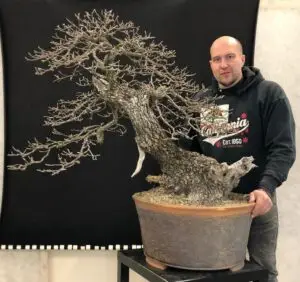Noah’s Arc of Learning
Noah Butler
Article 3: Pining for Better Health
I am indebted to the University of Iowa and University of Maryland Extension Offices, as well as Ryan Neil at Bonsai Mirai, for the valuable information they provided concerning the identification and prevention of pine needle cast.
Needle cast on pines is very common. Less common is an understanding of where this infection comes from and how to formulate a plan of action regarding treatment and prevention. Although infections occur initially in the spring, the effects of needle cast are generally not obvious until late summer or fall. Given this timeline, it seemed reasonable to cover this topic early in the growing season so club members can take steps to prevent needle cast!
The vast majority of needle cast infections are caused by one of three distinct types of fungi, including Dothistroma septosporum, Lophodermium seditiosum, and Mycosphaerella pini. The good news is that the methods to address the core problem are the same for all three species. All pines can be infected and suffer badly from needle cast, but the most susceptible tree species are ponderosa and Austrian pines. Japanese black and red pines, Japanese white pines, and Mugo and Scots pines exhibit a slightly greater degree of resistance.
Fungi have complicated life cycles that consists of a dormant spore phase and an active growth phase. Fungal spores on your juniper germinate (hatch) when temperatures remain close to or above 50 F and humidity remains high. The fungi grow and change their appearance and hyphae (long filamentous branches) are produced. These hyphal extensions will burrow into delicate new growth on plants, sucking up nutrients as they continue to divide and increase their abundance.

Fig. 1: Characteristic yellow and black bands at or near the center of older needles. Needles rupture and spread new spores from the white residue in the center of the band. Photo credit: University of Maryland Extension Office.
Identification
As noted above, evidence of needle cast will generally only show up later in the summer and fall. Infected needles will present with yellowing at the needle tip and a sharp yellow and black band in the middle of the needle (Fig. 1). Sometimes sap will emerge at the black band leaving a white residue. The sap indicates that fungal spores have erupted and burst open the needle in that location. When needles are heavily infected and very badly suffering, yellow/browning discoloration may extend from the band to the tip of the needle (Fig. 2).

Fig. 2. When needles are heavily infected, yellow/brown discoloration may extend all the way from the band to the distal tip. Photo credit: University of Massachusetts Extension Office.
Unfortunately, once you see needle cast, there is really nothing that can be done to “cure” the infected needles. Don’t pluck or cut off the infected needles! The pine needs to move water and generate sugars and these needles are still photosynthesizing. Older, year two and year three needles are likely to show evidence of banding first. Those needles will eventually die and fall off the tree. But here is the kicker: the banded, older needles got infected either last year or the year before! Younger, newly emerging needles will almost never show signs of needle cast, even though these needles are the most susceptible to initially getting infected in the spring.
An important consideration is thatneedle banding also could b e nutrient deficiency, so it is important to determine if the problem is truly a fungal infection or whether it’s a nutrient problem. To distinguish between these possibilities, consider whether the banding and discoloration is either spread across the entire tree or whether the banding is present on both young and old needles and has been there for the duration of the growing season. If either of those two options fit your scenario, then the issues are more likely to be nutrient related. On the other hand, if you observe that some areas of the tree are perfectly healthy and the banding is isolated to specific regions, or if the banding appears in an uneven distribution pattern, then it’s very likely to be a needle cast fungal infection. It’s also worth noting that needle cast is most common on lower branches, because either rain or watering from above will wash the spores (Fig. 3) from the upper canopy and deposit them on the lower branches. Spores are also spread via wind and handling.

Fig. 3. Fungal spores on young needles can be observed with magnification. Photo credit: Iowa State University Extension Office.
Treatment, Prevention and Recovery
Unfortunately, organic approaches are not particularly effective against needle cast. That said, if you don’t currently have a needle cast issue in your garden, then you would be wise not to introduce pines into your collection that exhibit signs if this disease. You should rotate tree so affected areas receive more sun. It’s also worth reiterating that there is no treatment for the infected needles. Just leave them alone. The treatment plan is directed at protecting new needles from becoming infected (by spores released from the older, banded needles) until they have time to harden off and form a waxy, protective cuticle.
The most effect agent to combat the fungus is Daconil (fig. 4), which you can pick up at any garden center or home center. Daconil is superior because it is thick and it coats young, emerging needles and protects them until they form their own natural defense (the waxy cuticle). Start in the early spring when temperatures stably hover around 50 degrees F and treat ever 7-10 days until the needles harden off, which generally occurs by late-May/early-June. It is also advisable to rotate Daconil with another fungicide spray, and Bonide copper-based fungicide 811 Copper 4E is another effective option. My research has also turned up evidence to support the use of systemic fungicides, which are taken up by the roots and distributed to all parts of the tree through the vasculature tissues. If you choose to use a systemic, the recommendation is for Cleary 3336 granular lawn fungicide. However, our bonsai are not lawns, so some caution should be used when selecting the appropriate dose for your potted pint trees. This is another reason why I default to spraying Daconil and Bonide (aside from the fact that the Creary 3336 product comes in 80lb. bags for your lawn! Yikes! Too much for me).

Fig. 4. The best measure to limit needle cast invasion of fresh spring needle growth. Applications should continue until needles mature and form their own protective waxy coating by early summer.
Three additional notes: 1) Remember, old infected needles and the spores are not affected by these fungicides. You’ll be spraying to protect the young needles; 2) If you have multiple pines in your collection, it is important that you do not handle the foliage of multiple trees when they’re wet, as this can transport spores (that stick to your hands) from one tree to another; and 3) if spraying Daconil, make sure none of it gets on nearby spruce trees, as Daconil is highly toxic to spruce.
In summary, dealing with needle cast really comes down to preventing the new spring needles from becoming infected by the spores released from the older infected needles with yellow and black bands. After a few growing seasons, the older infected needles will die, fall away, and become replaced by new growth. When the tree starts to produce robust new needle mass, then you know you’re coming out of the woods, but this could take as much as 18 months. This is a long-term fight. But hang in there!
I hope this information on needle cast proves useful for those of you cultivating pines. If you have questions, comments or requests for clarification, please let me know. I would also be happy to also hear suggestions about topics for future articles. Contact me at, noahsullivanbutler@gmail.com.
This article reprinted with permission from the Iowa Bonsai Association News, April 2021, Volume 77, Issue 3.



